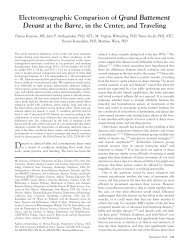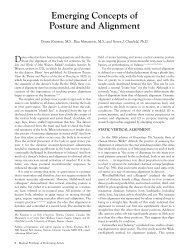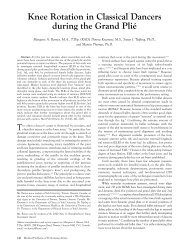And the Dance Goes On - Conditioning-with-Imagery
And the Dance Goes On - Conditioning-with-Imagery
And the Dance Goes On - Conditioning-with-Imagery
Create successful ePaper yourself
Turn your PDF publications into a flip-book with our unique Google optimized e-Paper software.
106 Journal of <strong>Dance</strong> Medicine & Science Volume 5, Number 4 2001<br />
sionals, who <strong>the</strong>y believe lack an<br />
appreciation of <strong>the</strong> dance world.<br />
Thus, dancers have quite different<br />
values and priorities from people in<br />
mainstream careers. In what o<strong>the</strong>r<br />
profession does one train for 10<br />
years or more, investing time,<br />
money and energy, <strong>with</strong> <strong>the</strong> knowledge<br />
that gainful employment is<br />
uncertain and that even success may<br />
involve living at poverty levels?<br />
Recently researchers have begun<br />
to investigate <strong>the</strong>se matters. This<br />
special issue of this journal is evidence<br />
of <strong>the</strong> topic’s importance, and<br />
<strong>the</strong> dance medicine and science<br />
community’s commitment to understanding<br />
and advancing matters<br />
germane to <strong>the</strong> psyche of dancers in<br />
relation to injury prevention, education,<br />
and treatment. This study<br />
will provide an overview of <strong>the</strong> current<br />
state of knowledge regarding<br />
<strong>the</strong> psychological and psychosocial<br />
impact of injury on <strong>the</strong> dancer. Existing<br />
scientific information is reviewed,<br />
followed by an overview of<br />
implications for research and practice.<br />
Psychological Reactions to<br />
Athletic Injury<br />
We can look to sport psychology to<br />
begin to understand <strong>the</strong> psychological<br />
consequences of injury for <strong>the</strong><br />
dancer. In <strong>the</strong> 1980s investigators<br />
began to explore athletes’ reactions<br />
to injury and rehabilitation. 17-21<br />
They started by examining <strong>the</strong> postulate<br />
that <strong>the</strong> reaction to sport injury<br />
is <strong>the</strong> same as <strong>the</strong> grief reaction<br />
associated <strong>with</strong> death and dying.<br />
Elizabeth Kubler-Ross’ five-stage<br />
<strong>the</strong>ory (shock/denial, anger, bargaining,<br />
depression, and acceptance)<br />
was presumed to describe an<br />
athlete’s psychological experience<br />
following injury. However, this presumption<br />
proved not to be supported<br />
by empirical evidence; it was<br />
based solely on anecdotal evidence<br />
and speculation. Over <strong>the</strong> past 12<br />
years research has flourished concerning<br />
<strong>the</strong> psychology of athletic<br />
injury. Numerous studies have investigated<br />
<strong>the</strong> impact of injury, 20-25<br />
and <strong>the</strong>ory development is well un-<br />
derway. 22-26 Evidence strongly suggests<br />
that Kubler-Ross’ <strong>the</strong>ory does<br />
not explain an athlete’s reaction to<br />
physical injury; however, one still<br />
may stumble upon written and verbal<br />
discussions that endorse a similarity.<br />
27,28<br />
Empirical studies, both quantitative<br />
and qualitative, suggest that<br />
<strong>the</strong>re are cognitive, emotional, and<br />
social consequences of sport injury.<br />
22,24,29-31 Injured athletes experience<br />
a variety of emotions that are<br />
initially, and primarily, negative,<br />
followed by moments of optimism.<br />
24 <strong>And</strong>ersen and Williams 22<br />
proposed a stress response model<br />
that hypo<strong>the</strong>sizes <strong>the</strong> following factors<br />
as influences on injury occurrence:<br />
personality (e.g., competitive<br />
trait anxiety, locus of control, hardiness,<br />
achievement motivation),<br />
history of stressors (previous injuries,<br />
life events), and coping resources<br />
(social support, coping behaviors).<br />
A number of studies have<br />
supported <strong>the</strong>ir model. 32 Wiese-<br />
Bjornstal and colleagues developed<br />
an integrated model of response to<br />
sport injury that builds on <strong>And</strong>ersen<br />
and Williams’ pre-injury model. 26,22<br />
This model depicts factors hypo<strong>the</strong>sized<br />
to influence athletes’ response<br />
to injury (person factors such as injury<br />
experience, and individual difference<br />
factors such as psychological,<br />
demographic, and physical<br />
factors), as well as features of <strong>the</strong><br />
actual response (cognitive, emotional,<br />
and behavioral). Brewer developed<br />
a cognitive appraisal model<br />
of psychological adjustment to athletic<br />
injury. 23 It suggests that personal<br />
and situational factors lead<br />
first to a cognitive appraisal of <strong>the</strong><br />
injury, which in turn leads to an<br />
emotional response, and <strong>the</strong>n a behavioral<br />
response to injury and rehabilitation.<br />
According to Brewer,<br />
cognitive appraisal models account<br />
for individual differences in response<br />
to injury, whereas grief models<br />
do not. Consistent <strong>with</strong> stress<br />
and coping models, cognitive appraisal<br />
models focus on <strong>the</strong> cognitive<br />
interpretation of injury. Data<br />
driven models that describe <strong>the</strong> ex-<br />
perience of injury from <strong>the</strong> athletes’<br />
perspective have been offered by<br />
Rose and Jevne 25 and by<br />
Mainwaring. 24 Rose and Jevne proposed<br />
four phases in <strong>the</strong> impact of<br />
injury: getting injured, acknowledging<br />
<strong>the</strong> injury, dealing <strong>with</strong> <strong>the</strong> impact<br />
of <strong>the</strong> injury, and achieving a<br />
physical and social outcome.<br />
Mainwaring’s model suggests an interaction<br />
between <strong>the</strong> injured<br />
athlete’s experience of injury (<strong>the</strong><br />
person) and <strong>the</strong> environment (<strong>the</strong><br />
situation), and depicts a holistic reaction<br />
that is multidimensional<br />
ra<strong>the</strong>r than linear. 24 It outlines psychological,<br />
physical, and social consequences<br />
and experiences of injury.<br />
All of <strong>the</strong> models cited are based on<br />
empirical and clinical evidence, and<br />
none support Kubler-Ross’ grief<br />
<strong>the</strong>ory as relevant for injured athletes.<br />
In essence, <strong>the</strong> current empirical<br />
work on <strong>the</strong> impact of athletic injury<br />
reveals that athletes view injury<br />
as stressful, and its consequence may<br />
disrupt an athlete’s sense of identity.<br />
33 For first-time serious injuries,<br />
athletes experience shock, frustration,<br />
depression, anxiety, fear, and<br />
anger in <strong>the</strong> first few weeks post injury.<br />
4,24,25,31,34,35 Fluctuations in<br />
negative and positive emotion occur<br />
in relation to daily events and<br />
progress in rehabilitation. Optimism<br />
and happiness are often associated<br />
<strong>with</strong> perceived gains in rehabilitation,<br />
24,36,37 whereas <strong>the</strong><br />
corollary – greater pain, frustration,<br />
fear, and pessimism – may be experienced<br />
in relation to decreases in<br />
range of motion. 37 Athletes seem to<br />
cope differently <strong>with</strong> second-time or<br />
third-time injuries than <strong>the</strong>y do<br />
<strong>with</strong> first-time injuries, 38 and differently<br />
<strong>with</strong> chronic and acute injuries.<br />
39 Johnson reported that multiply-injured<br />
athletes had greater<br />
capacity to accept injury, higher levels<br />
of social orientation and activity,<br />
and less anxiety about subsequent<br />
injuries than did first-time<br />
injured athletes. 38 In addition, <strong>the</strong>y<br />
experienced injuries as less stressful<br />
and threatening. Johnson suggests<br />
that experience <strong>with</strong> severe injury





